The 2017 hurricane season has been one of the most terrifying and damaging in recent memory. It’s also now among the top ten most active hurricane seasons in history. According to the Weather Channel, the Atlantic Ocean has, through September 30, 2017, spawned “13 named storms, eight hurricanes, and five major (Category 3 or stronger) hurricanes…”.
Three of those storms – Irma, Harvey and Maria – caused massive damage to the United States.
In addition to the hurricanes that devastated the US gulf coast and territories, severe wild fires have also ravaged the Pacific Northwest, including parts of Oregon and other surrounding states, in August and September, causing significant property damage.
With the potential (and likelihood) for serious and frequent natural disasters in the future, it’s essential to start looking at innovative ways that the government and military can better leverage commercial technologies to enable timely responses to natural disasters. This includes evaluating and assessing ways connectivity can quickly be restored to areas impacted in disaster response scenarios.
A wide array of tools and resources are available to first responders, everything from rapidly deployable satellite communications systems to unmanned aerial systems (UAS) that can be used for surveillance.
UAS are capable of prolonged flight over impacted areas and can transmit high resolution photographs and sensor data back to decision makers, who can use it to make operational decisions that might enable aid to get to the right place in the most expeditious manner while ensuring the safety of everyone involved. COMSATCOM solutions can deliver the necessary connectivity for piloting these aircraft, as well as the low-latency connectivity necessary for delivering the intelligence they gather back to those that need it.
The use of these platforms could start to increase thanks in large part to something going on within the Air Force – which in the process of upgrading its UAS fleet from the MQ-1 UAS to the MQ-9. This could lead to MQ-1 resources trickling down to organizations responsible for disaster relief. In fact, this idea was recently floated during a UAS panel at the AFA Conference in September 2017.
When asked about the current plans for the MQ-1, 432nd Wing Commander, Col. Julian Cheater, said, “We’re still recapitalizing a lot of the equipment from the MQ-1s for use on the MQ-9s. [Following that] there will be a considerable amount of the MQ-1s and there’s no real plan at this point. Is there a non-military use for these? For example – a hurricane? Can Homeland Security fly these and use them for those reasons…?”
But even with these tools in place, something has to bring them together and provide the connectivity necessary to power them.
The role of satellite in disaster response
Aside from washing away critical infrastructure, hurricanes and wild fires can also wash away vulnerable terrestrial cellular and network infrastructure, as well. In these environments, satellite and commercial satellite communications services can be the key to keeping a humanitarian response initiative connected and effective. Today’s commercial satellite solutions can deliver high-throughput, fiber-like connections to practically any spot on Earth, providing the connectivity necessary to continually track social media activity of survivors and deliver real-time intelligence to first responders. This is all possible even without existing terrestrial networks, making satellite ideal for places where infrastructure has been compromised.
This hurricane and wildfire season has been downright destructive for the U.S. and the future promises to hold even more destruction, thanks to increasingly frequent and increasingly powerful disasters. Luckily, a new generation of military, civilian and commercial technologies could play a role in making our disaster response and emergency preparedness even better. But without satellite, these network connected and network enabled platforms may not be available for disaster response efforts when we need them.
To learn more about the role that COMSATCOM can play in disaster response and emergency preparedness, click on the resources below:
High Throughput Satellites for U.S. Government Applications
Operational Trial Of A Satellite Communication System For New Jersey’s First Responders
